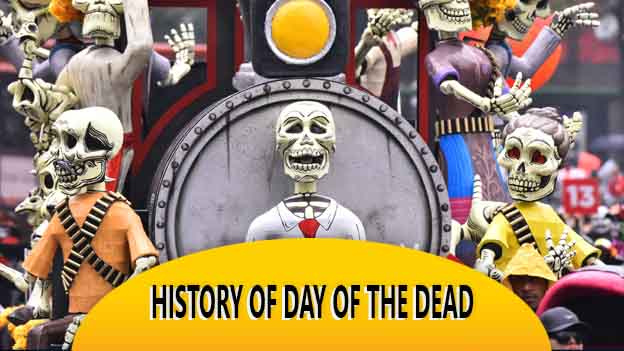History Of Day Of The Dead: The Day of the Dead, known as Día de los Muertos, is a vibrant and significant cultural celebration originating from Mexico. This unique festival honors deceased loved ones and ancestors, blending indigenous Mesoamerican rituals with Catholicism. Over the centuries, it has become a colorful and joyful tradition that brings families together to remember and honor the departed. In this article, we’ll delve into the fascinating history of the Day of the Dead, exploring its origins, customs, and significance.
The Origins of Día de los Muertos
Pre-Columbian Roots
The roots of the Day of the Dead trace back to ancient Mesoamerican civilizations such as the Aztecs, Mayans, and Toltecs. These cultures had deep beliefs in the afterlife and the continuation of existence after death. They viewed death as a natural phase in the cycle of life and celebrated it with rituals, ceremonies, and offerings to honor their deceased.
The Influence of Catholicism
With the arrival of the Spanish conquistadors in the 16th century, Catholicism began to merge with indigenous beliefs. The All Saints’ Day (November 1) and All Souls’ Day (November 2) in the Christian calendar coincided with the indigenous festival, leading to the evolution of the Day of the Dead as it is known today. History Of Day Of The Dead.
The Celebration of Life and Death
Building Altars (Ofrendas)
One of the central practices during the Day of the Dead is building altars dedicated to departed souls. Families create elaborate ofrendas adorned with marigold flowers, candles, photographs, favorite foods, and mementos of the deceased. These altars are believed to guide the spirits of loved ones back to the world of the living.
Calaveras and Calacas
Calaveras, meaning skulls, and calacas, meaning skeletons, are iconic symbols of the festival. People paint their faces to resemble skulls, don vibrant costumes, and take part in parades to celebrate life and death. This joyous and colorful display is a testament to the belief that death is not something to fear but rather a part of life’s natural cycle.
Visiting Cemeteries
Families visit cemeteries during the celebration, where they clean and decorate the graves of their loved ones. It is a time for prayers, reflection, and sharing stories about the deceased, fostering a sense of connection with their ancestors.
- Also Read:
Regional Variations
Mexico’s Diverse Traditions
Mexico’s different regions have their unique interpretations of the Day of the Dead. For instance, in the state of Michoacán, the celebration lasts for several days, including a candlelight procession to the cemetery. In Oaxaca, families decorate the graves with sand paintings, and the festivities include a lively carnival atmosphere.
Global Influence
In recent years, the Day of the Dead has gained popularity beyond Mexico’s borders. Many cities around the world now hold their own Day of the Dead events, featuring art exhibits, street performances, and traditional Mexican cuisine.
Misconceptions and Stereotypes
Misinterpretation of the Festival
Despite its rich history and cultural significance, the Day of the Dead has sometimes been misunderstood or misrepresented. It is essential to respect the traditions and avoid appropriating elements of the celebration without understanding their true meaning.
Distinguishing from Halloween
While the Day of the Dead falls around the same time as Halloween, they are distinct events with different origins and purposes. Halloween has its roots in Celtic traditions, focusing on warding off evil spirits, whereas the Day of the Dead celebrates and honors deceased loved ones.
Day of the Dead Today
In modern times, the Day of the Dead remains a cherished and vital part of Mexican culture, promoting unity, family bonds, and a deeper appreciation for life and death. It serves as a beautiful reminder that even in death, our loved ones’ memories continue to live on.
Conclusion
History Of Day Of The Dead: The Day of the Dead is more than just a festival; it is a cultural celebration deeply embedded in Mexico’s history and identity. This unique blend of ancient Mesoamerican beliefs and Catholic customs has evolved into a vibrant, colorful, and joyous event that not only honors the departed but also enriches the lives of those still living. As the tradition spreads its roots globally, it is essential to embrace its true significance and value its contribution to humanity’s understanding of life and death.
FAQs: History Of Day Of The Dead
-
Is the Day of the Dead a somber event?
The Day of the Dead is a festive and joyous occasion where families come together to celebrate the lives of their deceased loved ones.
-
Is the Day of the Dead celebrated only in Mexico?
While it originated in Mexico, the Day of the Dead is now celebrated in various parts of the world, especially where there are significant Mexican communities.
-
Are calaveras and calacas the same thing?
Calaveras refer to skulls, while calacas refer to skeletons. Both are central symbols of the Day of the Dead.
-
How do people prepare for the Day of the Dead?
Families prepare for the Day of the Dead by building altars, cleaning and decorating graves, and gathering items for ofrendas.
-
What is the significance of marigold flowers during the festival?
Marigold flowers are believed to guide the spirits of the departed back to the world of the living during the Day of the Dead celebrations.
